HLT54115 Nursing Diploma: Cultural Safety Clinical Scenario Report
VerifiedAdded on 2023/06/04
|8
|1372
|156
Report
AI Summary
This assignment presents a clinical scenario centered on an Indigenous child and their family, requiring an understanding of cultural safety principles in nursing. It addresses the social determinants of health affecting Indigenous communities, such as poverty and access to healthcare, and emphasizes the importance of cultural awareness and sensitivity in nursing practice. The assignment explores the Aboriginal and Torres Strait Islander Act 2005, racism, discrimination, and communication barriers faced by Indigenous people in healthcare. It highlights the need for culturally competent care, addressing potential biases and misunderstandings in healthcare settings. The responses also reflect on personal placements, cultural preferences, and potential questions from Indigenous families regarding healthcare services. This report provides valuable insights into culturally responsive nursing care for Indigenous populations. Desklib is a platform where students can find a wide array of resources, including past papers and solved assignments, to support their academic endeavors.
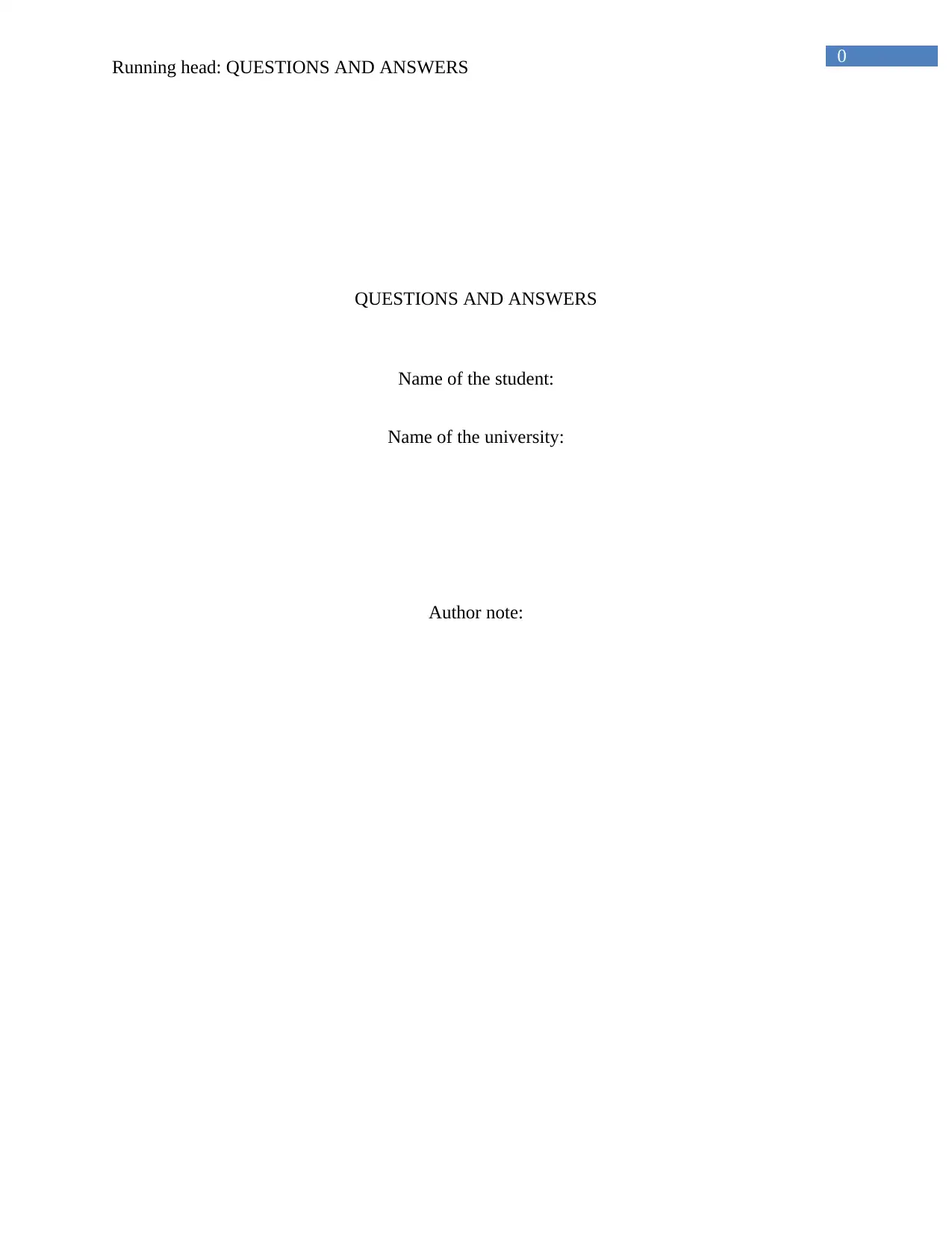
0
Running head: QUESTIONS AND ANSWERS
QUESTIONS AND ANSWERS
Name of the student:
Name of the university:
Author note:
Running head: QUESTIONS AND ANSWERS
QUESTIONS AND ANSWERS
Name of the student:
Name of the university:
Author note:
Paraphrase This Document
Need a fresh take? Get an instant paraphrase of this document with our AI Paraphraser
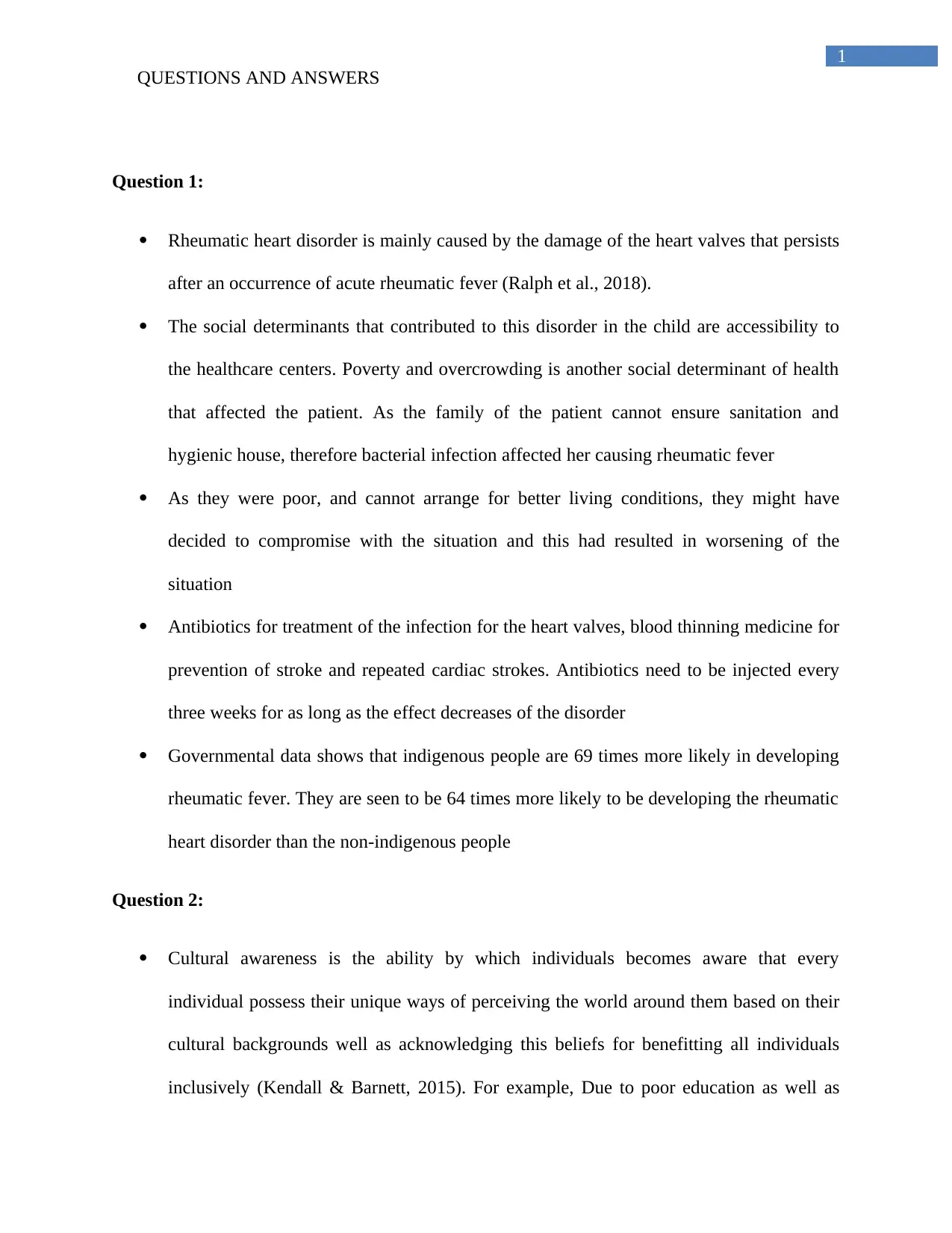
1
QUESTIONS AND ANSWERS
Question 1:
Rheumatic heart disorder is mainly caused by the damage of the heart valves that persists
after an occurrence of acute rheumatic fever (Ralph et al., 2018).
The social determinants that contributed to this disorder in the child are accessibility to
the healthcare centers. Poverty and overcrowding is another social determinant of health
that affected the patient. As the family of the patient cannot ensure sanitation and
hygienic house, therefore bacterial infection affected her causing rheumatic fever
As they were poor, and cannot arrange for better living conditions, they might have
decided to compromise with the situation and this had resulted in worsening of the
situation
Antibiotics for treatment of the infection for the heart valves, blood thinning medicine for
prevention of stroke and repeated cardiac strokes. Antibiotics need to be injected every
three weeks for as long as the effect decreases of the disorder
Governmental data shows that indigenous people are 69 times more likely in developing
rheumatic fever. They are seen to be 64 times more likely to be developing the rheumatic
heart disorder than the non-indigenous people
Question 2:
Cultural awareness is the ability by which individuals becomes aware that every
individual possess their unique ways of perceiving the world around them based on their
cultural backgrounds well as acknowledging this beliefs for benefitting all individuals
inclusively (Kendall & Barnett, 2015). For example, Due to poor education as well as
QUESTIONS AND ANSWERS
Question 1:
Rheumatic heart disorder is mainly caused by the damage of the heart valves that persists
after an occurrence of acute rheumatic fever (Ralph et al., 2018).
The social determinants that contributed to this disorder in the child are accessibility to
the healthcare centers. Poverty and overcrowding is another social determinant of health
that affected the patient. As the family of the patient cannot ensure sanitation and
hygienic house, therefore bacterial infection affected her causing rheumatic fever
As they were poor, and cannot arrange for better living conditions, they might have
decided to compromise with the situation and this had resulted in worsening of the
situation
Antibiotics for treatment of the infection for the heart valves, blood thinning medicine for
prevention of stroke and repeated cardiac strokes. Antibiotics need to be injected every
three weeks for as long as the effect decreases of the disorder
Governmental data shows that indigenous people are 69 times more likely in developing
rheumatic fever. They are seen to be 64 times more likely to be developing the rheumatic
heart disorder than the non-indigenous people
Question 2:
Cultural awareness is the ability by which individuals becomes aware that every
individual possess their unique ways of perceiving the world around them based on their
cultural backgrounds well as acknowledging this beliefs for benefitting all individuals
inclusively (Kendall & Barnett, 2015). For example, Due to poor education as well as
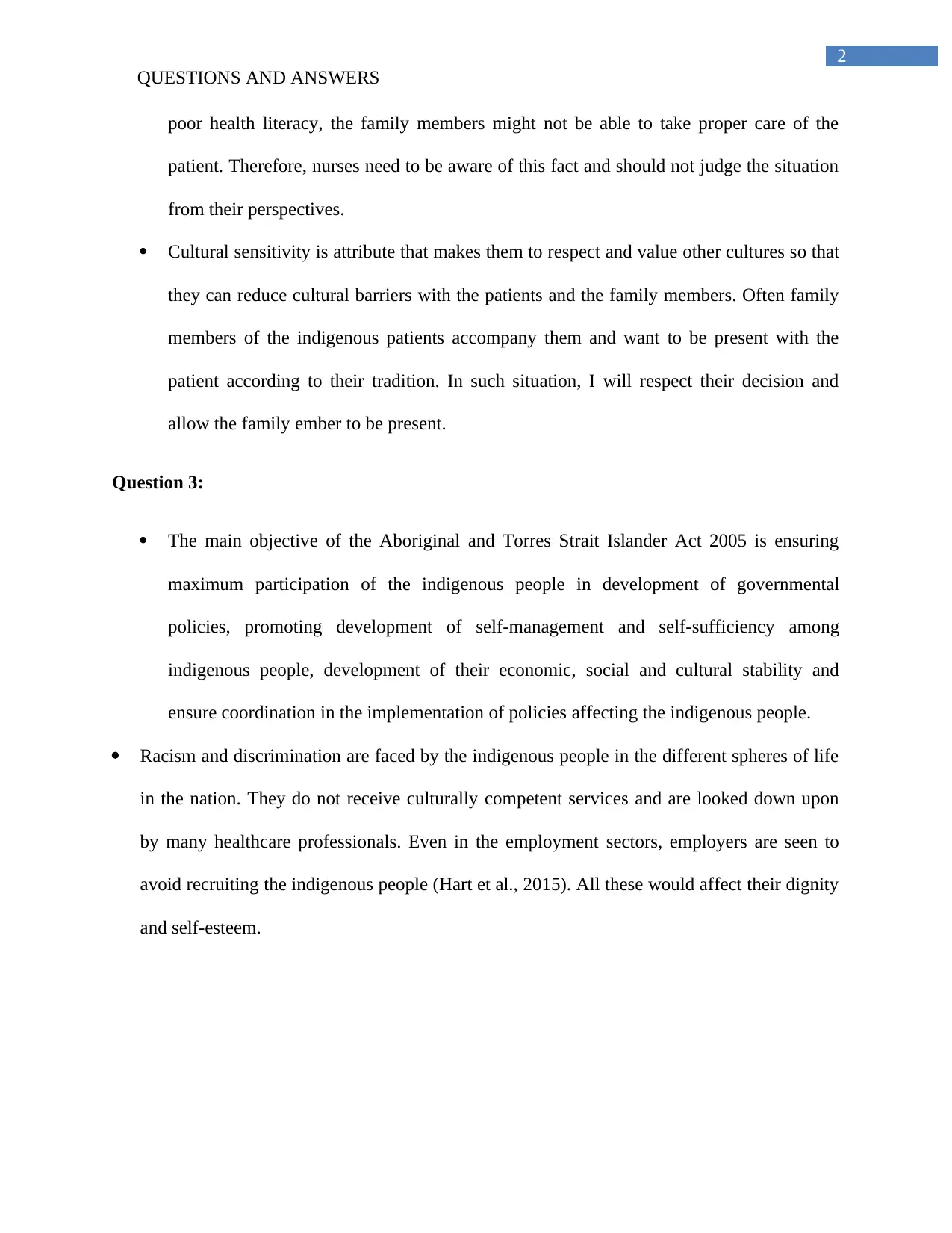
2
QUESTIONS AND ANSWERS
poor health literacy, the family members might not be able to take proper care of the
patient. Therefore, nurses need to be aware of this fact and should not judge the situation
from their perspectives.
Cultural sensitivity is attribute that makes them to respect and value other cultures so that
they can reduce cultural barriers with the patients and the family members. Often family
members of the indigenous patients accompany them and want to be present with the
patient according to their tradition. In such situation, I will respect their decision and
allow the family ember to be present.
Question 3:
The main objective of the Aboriginal and Torres Strait Islander Act 2005 is ensuring
maximum participation of the indigenous people in development of governmental
policies, promoting development of self-management and self-sufficiency among
indigenous people, development of their economic, social and cultural stability and
ensure coordination in the implementation of policies affecting the indigenous people.
Racism and discrimination are faced by the indigenous people in the different spheres of life
in the nation. They do not receive culturally competent services and are looked down upon
by many healthcare professionals. Even in the employment sectors, employers are seen to
avoid recruiting the indigenous people (Hart et al., 2015). All these would affect their dignity
and self-esteem.
QUESTIONS AND ANSWERS
poor health literacy, the family members might not be able to take proper care of the
patient. Therefore, nurses need to be aware of this fact and should not judge the situation
from their perspectives.
Cultural sensitivity is attribute that makes them to respect and value other cultures so that
they can reduce cultural barriers with the patients and the family members. Often family
members of the indigenous patients accompany them and want to be present with the
patient according to their tradition. In such situation, I will respect their decision and
allow the family ember to be present.
Question 3:
The main objective of the Aboriginal and Torres Strait Islander Act 2005 is ensuring
maximum participation of the indigenous people in development of governmental
policies, promoting development of self-management and self-sufficiency among
indigenous people, development of their economic, social and cultural stability and
ensure coordination in the implementation of policies affecting the indigenous people.
Racism and discrimination are faced by the indigenous people in the different spheres of life
in the nation. They do not receive culturally competent services and are looked down upon
by many healthcare professionals. Even in the employment sectors, employers are seen to
avoid recruiting the indigenous people (Hart et al., 2015). All these would affect their dignity
and self-esteem.
⊘ This is a preview!⊘
Do you want full access?
Subscribe today to unlock all pages.

Trusted by 1+ million students worldwide
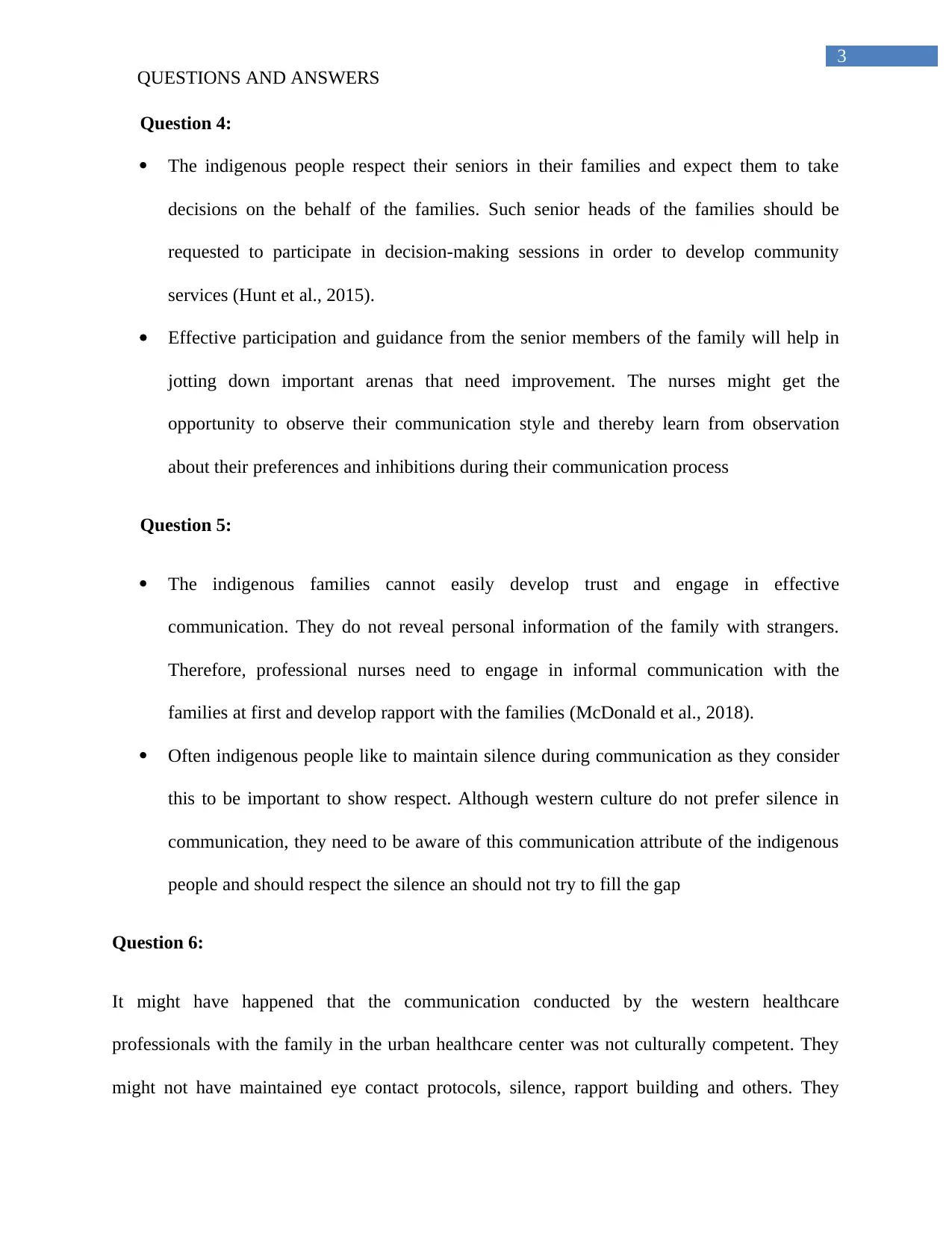
3
QUESTIONS AND ANSWERS
Question 4:
The indigenous people respect their seniors in their families and expect them to take
decisions on the behalf of the families. Such senior heads of the families should be
requested to participate in decision-making sessions in order to develop community
services (Hunt et al., 2015).
Effective participation and guidance from the senior members of the family will help in
jotting down important arenas that need improvement. The nurses might get the
opportunity to observe their communication style and thereby learn from observation
about their preferences and inhibitions during their communication process
Question 5:
The indigenous families cannot easily develop trust and engage in effective
communication. They do not reveal personal information of the family with strangers.
Therefore, professional nurses need to engage in informal communication with the
families at first and develop rapport with the families (McDonald et al., 2018).
Often indigenous people like to maintain silence during communication as they consider
this to be important to show respect. Although western culture do not prefer silence in
communication, they need to be aware of this communication attribute of the indigenous
people and should respect the silence an should not try to fill the gap
Question 6:
It might have happened that the communication conducted by the western healthcare
professionals with the family in the urban healthcare center was not culturally competent. They
might not have maintained eye contact protocols, silence, rapport building and others. They
QUESTIONS AND ANSWERS
Question 4:
The indigenous people respect their seniors in their families and expect them to take
decisions on the behalf of the families. Such senior heads of the families should be
requested to participate in decision-making sessions in order to develop community
services (Hunt et al., 2015).
Effective participation and guidance from the senior members of the family will help in
jotting down important arenas that need improvement. The nurses might get the
opportunity to observe their communication style and thereby learn from observation
about their preferences and inhibitions during their communication process
Question 5:
The indigenous families cannot easily develop trust and engage in effective
communication. They do not reveal personal information of the family with strangers.
Therefore, professional nurses need to engage in informal communication with the
families at first and develop rapport with the families (McDonald et al., 2018).
Often indigenous people like to maintain silence during communication as they consider
this to be important to show respect. Although western culture do not prefer silence in
communication, they need to be aware of this communication attribute of the indigenous
people and should respect the silence an should not try to fill the gap
Question 6:
It might have happened that the communication conducted by the western healthcare
professionals with the family in the urban healthcare center was not culturally competent. They
might not have maintained eye contact protocols, silence, rapport building and others. They
Paraphrase This Document
Need a fresh take? Get an instant paraphrase of this document with our AI Paraphraser
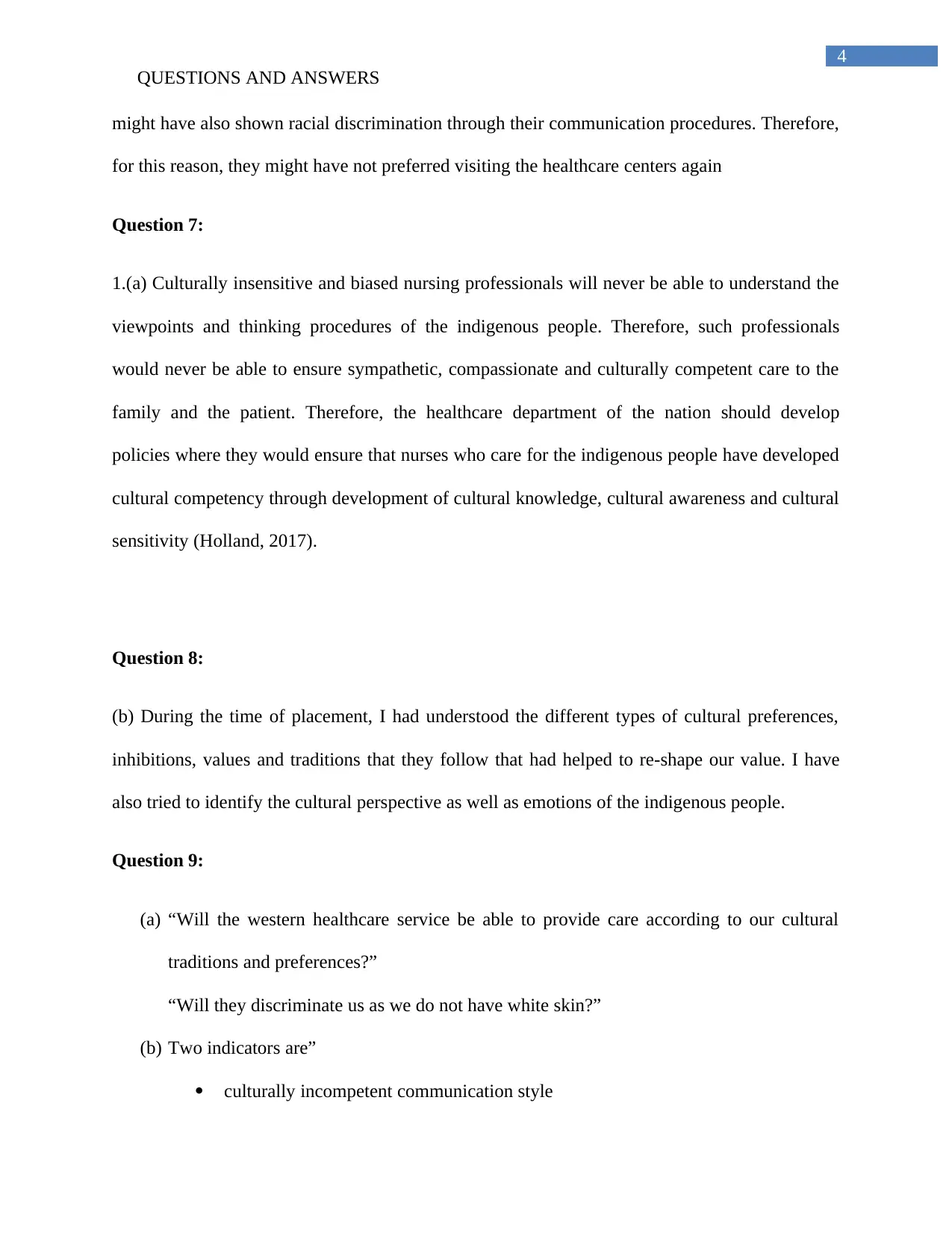
4
QUESTIONS AND ANSWERS
might have also shown racial discrimination through their communication procedures. Therefore,
for this reason, they might have not preferred visiting the healthcare centers again
Question 7:
1.(a) Culturally insensitive and biased nursing professionals will never be able to understand the
viewpoints and thinking procedures of the indigenous people. Therefore, such professionals
would never be able to ensure sympathetic, compassionate and culturally competent care to the
family and the patient. Therefore, the healthcare department of the nation should develop
policies where they would ensure that nurses who care for the indigenous people have developed
cultural competency through development of cultural knowledge, cultural awareness and cultural
sensitivity (Holland, 2017).
Question 8:
(b) During the time of placement, I had understood the different types of cultural preferences,
inhibitions, values and traditions that they follow that had helped to re-shape our value. I have
also tried to identify the cultural perspective as well as emotions of the indigenous people.
Question 9:
(a) “Will the western healthcare service be able to provide care according to our cultural
traditions and preferences?”
“Will they discriminate us as we do not have white skin?”
(b) Two indicators are”
culturally incompetent communication style
QUESTIONS AND ANSWERS
might have also shown racial discrimination through their communication procedures. Therefore,
for this reason, they might have not preferred visiting the healthcare centers again
Question 7:
1.(a) Culturally insensitive and biased nursing professionals will never be able to understand the
viewpoints and thinking procedures of the indigenous people. Therefore, such professionals
would never be able to ensure sympathetic, compassionate and culturally competent care to the
family and the patient. Therefore, the healthcare department of the nation should develop
policies where they would ensure that nurses who care for the indigenous people have developed
cultural competency through development of cultural knowledge, cultural awareness and cultural
sensitivity (Holland, 2017).
Question 8:
(b) During the time of placement, I had understood the different types of cultural preferences,
inhibitions, values and traditions that they follow that had helped to re-shape our value. I have
also tried to identify the cultural perspective as well as emotions of the indigenous people.
Question 9:
(a) “Will the western healthcare service be able to provide care according to our cultural
traditions and preferences?”
“Will they discriminate us as we do not have white skin?”
(b) Two indicators are”
culturally incompetent communication style
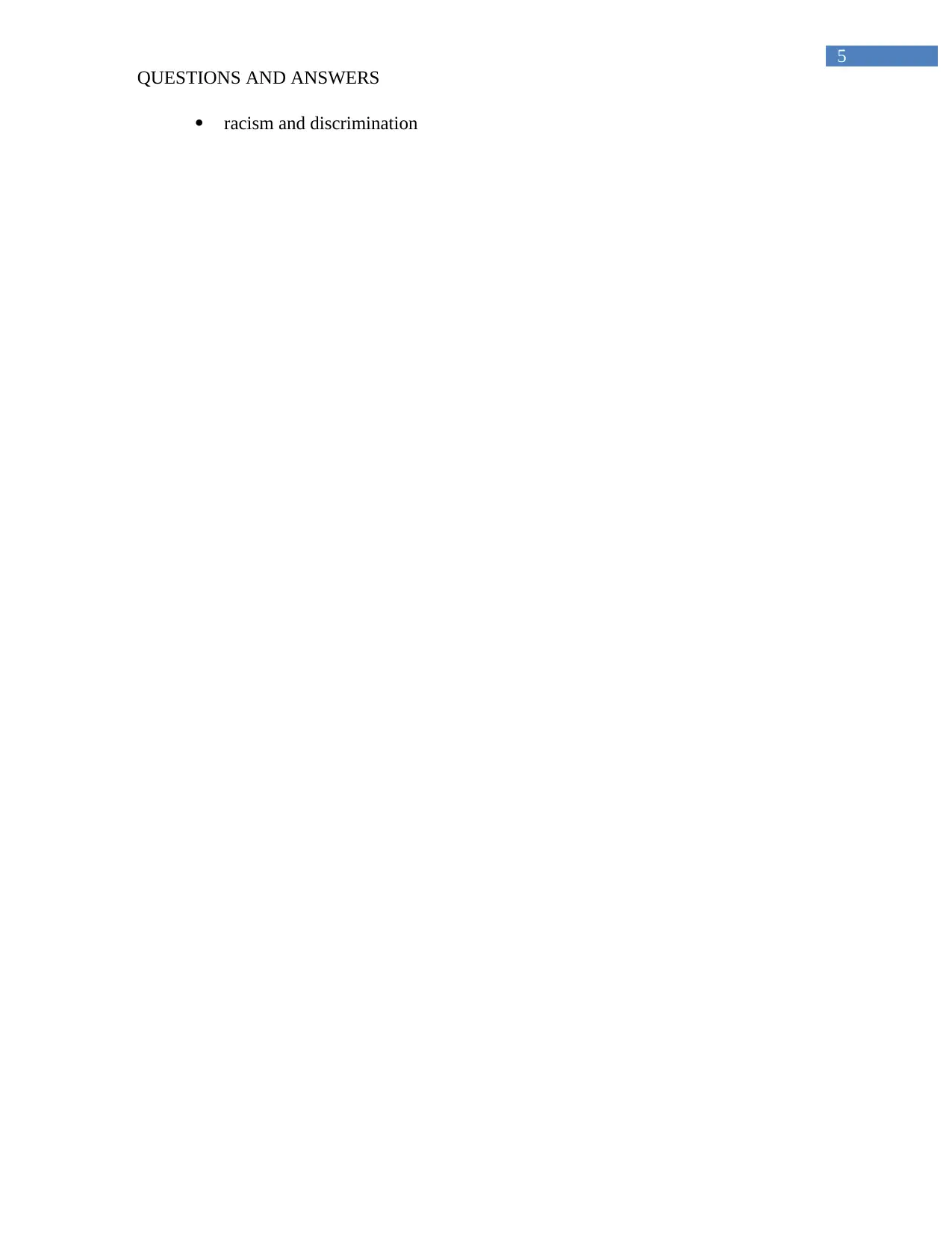
5
QUESTIONS AND ANSWERS
racism and discrimination
QUESTIONS AND ANSWERS
racism and discrimination
⊘ This is a preview!⊘
Do you want full access?
Subscribe today to unlock all pages.

Trusted by 1+ million students worldwide
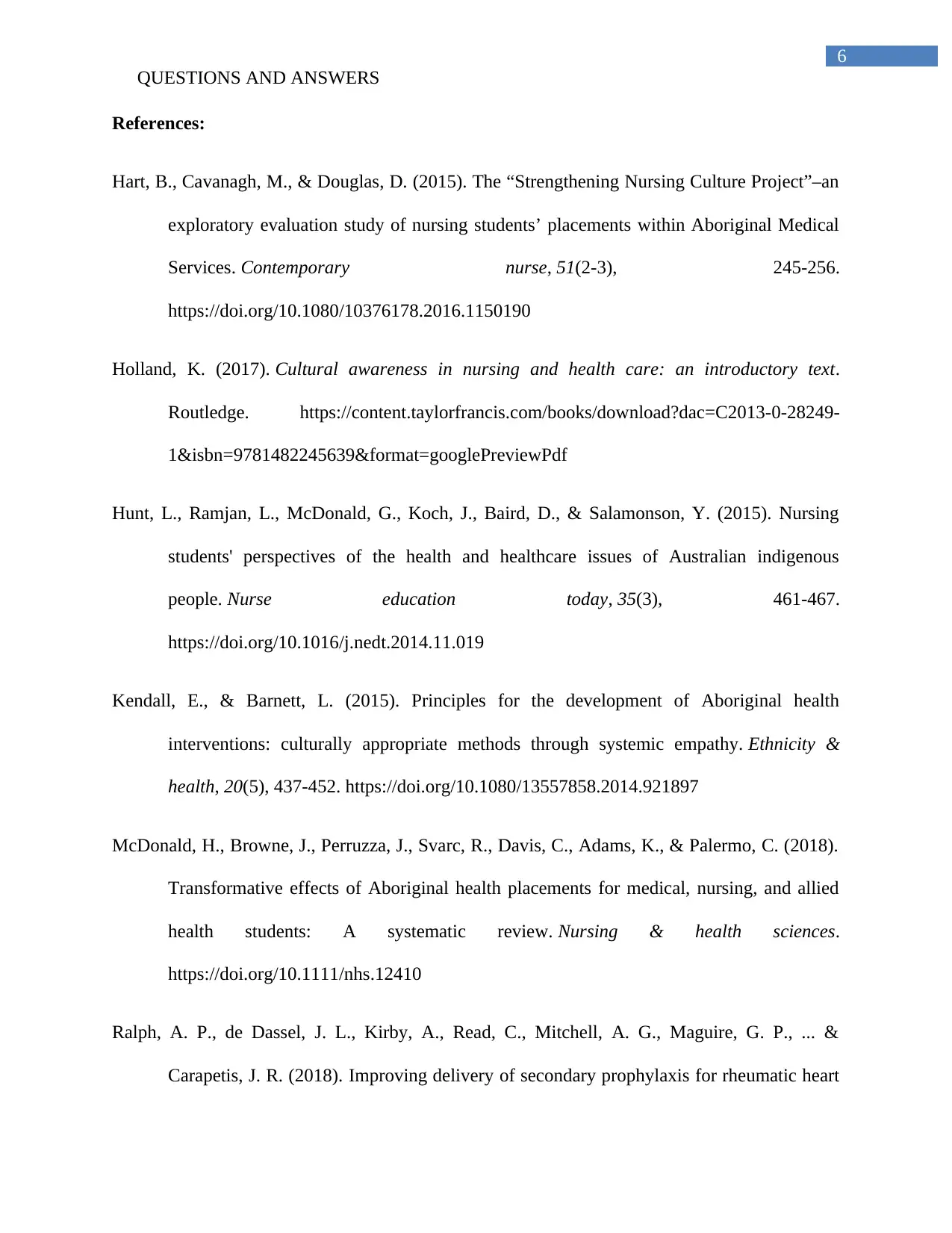
6
QUESTIONS AND ANSWERS
References:
Hart, B., Cavanagh, M., & Douglas, D. (2015). The “Strengthening Nursing Culture Project”–an
exploratory evaluation study of nursing students’ placements within Aboriginal Medical
Services. Contemporary nurse, 51(2-3), 245-256.
https://doi.org/10.1080/10376178.2016.1150190
Holland, K. (2017). Cultural awareness in nursing and health care: an introductory text.
Routledge. https://content.taylorfrancis.com/books/download?dac=C2013-0-28249-
1&isbn=9781482245639&format=googlePreviewPdf
Hunt, L., Ramjan, L., McDonald, G., Koch, J., Baird, D., & Salamonson, Y. (2015). Nursing
students' perspectives of the health and healthcare issues of Australian indigenous
people. Nurse education today, 35(3), 461-467.
https://doi.org/10.1016/j.nedt.2014.11.019
Kendall, E., & Barnett, L. (2015). Principles for the development of Aboriginal health
interventions: culturally appropriate methods through systemic empathy. Ethnicity &
health, 20(5), 437-452. https://doi.org/10.1080/13557858.2014.921897
McDonald, H., Browne, J., Perruzza, J., Svarc, R., Davis, C., Adams, K., & Palermo, C. (2018).
Transformative effects of Aboriginal health placements for medical, nursing, and allied
health students: A systematic review. Nursing & health sciences.
https://doi.org/10.1111/nhs.12410
Ralph, A. P., de Dassel, J. L., Kirby, A., Read, C., Mitchell, A. G., Maguire, G. P., ... &
Carapetis, J. R. (2018). Improving delivery of secondary prophylaxis for rheumatic heart
QUESTIONS AND ANSWERS
References:
Hart, B., Cavanagh, M., & Douglas, D. (2015). The “Strengthening Nursing Culture Project”–an
exploratory evaluation study of nursing students’ placements within Aboriginal Medical
Services. Contemporary nurse, 51(2-3), 245-256.
https://doi.org/10.1080/10376178.2016.1150190
Holland, K. (2017). Cultural awareness in nursing and health care: an introductory text.
Routledge. https://content.taylorfrancis.com/books/download?dac=C2013-0-28249-
1&isbn=9781482245639&format=googlePreviewPdf
Hunt, L., Ramjan, L., McDonald, G., Koch, J., Baird, D., & Salamonson, Y. (2015). Nursing
students' perspectives of the health and healthcare issues of Australian indigenous
people. Nurse education today, 35(3), 461-467.
https://doi.org/10.1016/j.nedt.2014.11.019
Kendall, E., & Barnett, L. (2015). Principles for the development of Aboriginal health
interventions: culturally appropriate methods through systemic empathy. Ethnicity &
health, 20(5), 437-452. https://doi.org/10.1080/13557858.2014.921897
McDonald, H., Browne, J., Perruzza, J., Svarc, R., Davis, C., Adams, K., & Palermo, C. (2018).
Transformative effects of Aboriginal health placements for medical, nursing, and allied
health students: A systematic review. Nursing & health sciences.
https://doi.org/10.1111/nhs.12410
Ralph, A. P., de Dassel, J. L., Kirby, A., Read, C., Mitchell, A. G., Maguire, G. P., ... &
Carapetis, J. R. (2018). Improving delivery of secondary prophylaxis for rheumatic heart
Paraphrase This Document
Need a fresh take? Get an instant paraphrase of this document with our AI Paraphraser
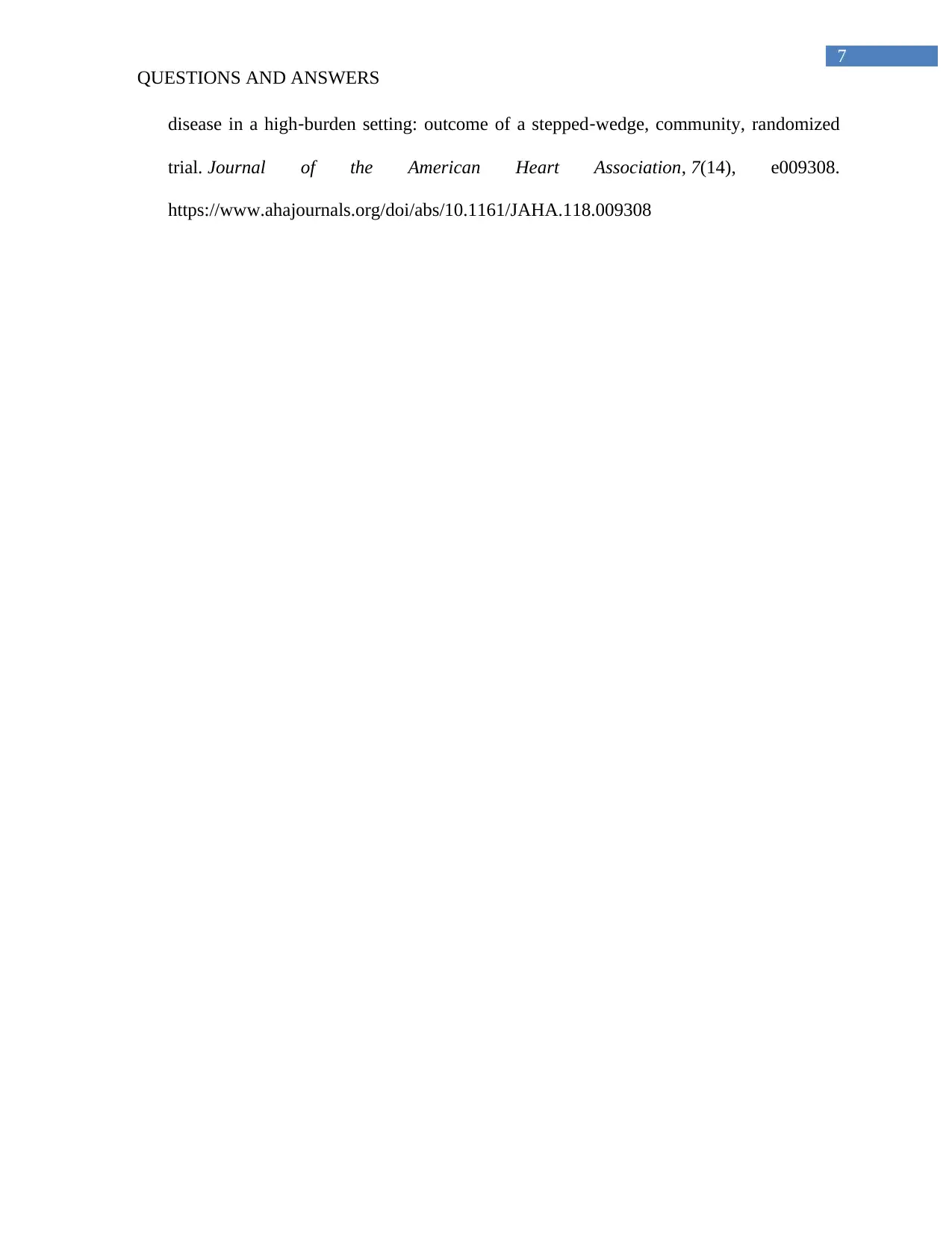
7
QUESTIONS AND ANSWERS
disease in a high‐burden setting: outcome of a stepped‐wedge, community, randomized
trial. Journal of the American Heart Association, 7(14), e009308.
https://www.ahajournals.org/doi/abs/10.1161/JAHA.118.009308
QUESTIONS AND ANSWERS
disease in a high‐burden setting: outcome of a stepped‐wedge, community, randomized
trial. Journal of the American Heart Association, 7(14), e009308.
https://www.ahajournals.org/doi/abs/10.1161/JAHA.118.009308
1 out of 8
Related Documents
Your All-in-One AI-Powered Toolkit for Academic Success.
+13062052269
info@desklib.com
Available 24*7 on WhatsApp / Email
![[object Object]](/_next/static/media/star-bottom.7253800d.svg)
Unlock your academic potential
Copyright © 2020–2025 A2Z Services. All Rights Reserved. Developed and managed by ZUCOL.





